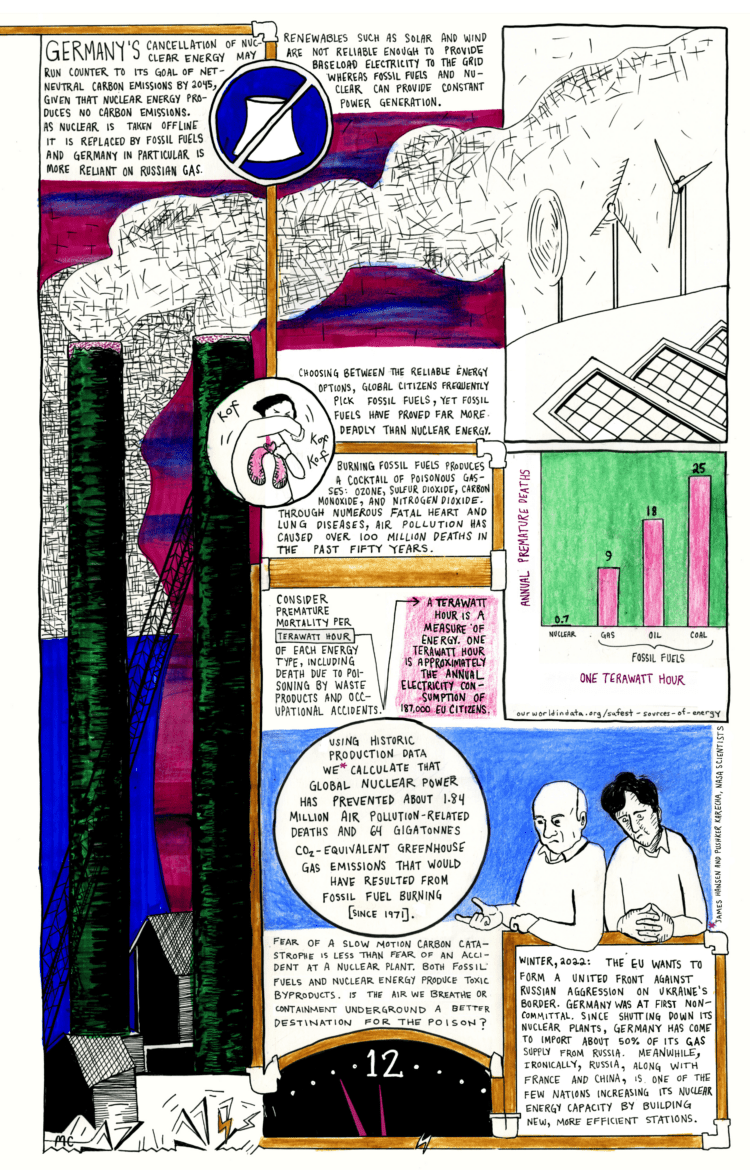Transcript:
Following the Fukushima disaster of 2011, then chancellor Angela Merkel pledged to close all nuclear power stations in Germany by 2022. “Canceler Merkel” may be an appropriate nickname.
The accident at Fukushima Daiichi power station began when the fourth most powerful earthquake ever recorded triggered a tsunami off the coast of Japan that sent a 14 meter tall wave over the plant’s seawall. Though the nuclear plant’s structure bore the tsunami without damage, seawater flooded into the room containing the backup generators. As a result, three of the six reactors melted down, causing radioactive waste to irradiate into the environment and inhabitants.
Fukushima resulted in 573 disaster-related deaths. Radiation, however, did not cause these deaths. Evacuation proved chaotic and fatal.
“Before Fukushima, it was assumed that if government officials are creating [evacuation] plans, accidents are bound to happen, so no one made plans,” Nose Yutaka, mayor of Takahama, told the Economist in 2021. “Now we have a plan.”
The long term estimate of deaths related to radiation exposure at Fukushima Daiichi range from 0-1000. Cases of thyroid cancer in children have increased, though, the World Health Organization (WHO) cites an increase in screening as a more probable explanation than radiation.
The worst nuclear energy accident in history occurred at Chernobyl, Ukraine in 1986. There, twenty-eight people died of acute radiation syndrome. The long-term fatalities due to radiation exposure from the Chernobyl accident hover over nuclear policy. Estimates of premature deaths by 2065 include 60,000 by the EU Green Party and 4,000 by the WHO. The United Nations Scientific Committee on the Effects of Atomic Radiation (UNSCEAR) does not give a figure, due to “unacceptable uncertainties in the predictions” but UNSCEAR did state that in projections of premature deaths, “the doses [of radiation from Chernobyl] were generally overestimated.”
Besides the fear of accidents, the lack of permanent storage solutions for nuclear waste worries citizens and policy-makers. Facilities that currently store spent fuel in the United States are considered temporary. This label is not for lack of technological solutions: Permanent storage and even recycling of nuclear spent fuel is possible. “The political system is unable to choose among feasible and demonstrated options,” Roger Blomquist told me. Blomquist is Principal Nuclear Engineer at Argonne National Laboratory.
Two examples of the political system determining the fate of nuclear energy: 1) The construction of a geologic disposal site at Yucca Mountain was halted at the urging of Nevada politicians after $12 billion had been invested in the site.
2) In a nuclear weapon non-proliferation effort, President Carter issued a statement in 1977 that “[deferred] indefinitely the commercial reprocessing and recycling of the plutonium produced in the U.S. nuclear power programs.”
Safety of nuclear waste storage is widely underestimated. Blomquist said, “You shouldn’t grind up [spent fuel] and eat it. You can stand next to shielded casks and be ok.”
Germany’s cancellation of nuclear energy may run counter to its goal of net-neutral carbon emissions by 2045 given that nuclear power stations produce no carbon emissions, and when nuclear energy is taken off line, it is replaced by fossil fuels. Germany’s climate-motivated effort to shutter coal-fired power stations has made it more reliant on foreign oil, especially from Russia.
Renewables such as solar and wind are not reliable enough to provide baseload electricity to the grid, whereas fossil fuels and nuclear energy can provide constant power generation.
Choosing between the reliable energy options, global citizens frequently pick fossil fuels, yet fossil fuels have proved far more deadly than nuclear energy.
Burning fossil fuels produces a cocktail of poisonous gasses: oxone, sulfur dioxide, carbon monoxide, and nitrogen dioxide. Through numerous fatal lung and heart diseases, air pollution has caused 100 million deaths over the past fifty years.
Consider premature mortality per terawatt hour of each energy type, due to poisoning by waste products and occupational accidents. A terawatt hour is a measure of energy: 1 terawatt hour is approximately the annual electricity consumption of 187,000 citizens in Europe.
- coal: 25
- oil: 18
- natural gas: 3
- nuclear: 0.07
NASA scientists James Hansen and Pushker Kharecha found that
“using historic production data, we calculate that global nuclear power has prevented about 1.84 million air pollution-related deaths and 64 gigatonnes carbon dioxide-equivalent greenhouse gas emissions that would have resulted from fossil fuel burning [since 1971.]”
Fear of a slow-motion carbon catastrophe is less than fear of accidents at a nuclear power station. Both fossil fuels and nuclear energy produce toxic byproducts. Is the air we breathe or containment underground a better destination for these poisons?
Winter, 2022. The EU wants to form a united front against Russian aggression on Ukraine’s border. Germany was at first noncommittal. Since shutting down its nuclear plants, Germany has come to rely on Russia for about 50% of its oil supply via the Nord Stream pipeline. Meanwhile, Russia, along with France and China, is one of the few nations increasing its nuclear energy capacity by building newer, more efficient stations.
__________________________________________________________________________
Author’s Note
My research on nuclear power began in earnest following a conversation with a friend of a friend who works as a consultant for small modular reactors, or those “newer, more efficient stations” that I touch on at the end of the article.
Unsurprisingly, the conversation about nuclear energy is fraught with disagreement: Is nuclear renewable? “No, but it’s our best ‘green’ bet.” Is nuclear power worth the risk? “Absolutely not.” Will nuclear plants disguise the development of weapons? “Oof.”
Seeing this maelstrom of opinion, I did what has become a mantra of the (mis)information age: I reached out to trusted experts. I am good friends with a couple who are practicing experts in the energy sector. She remotely troubleshoots wind turbines for a major electrical utility in the Northeast; He holds a doctorate in material science and works in a Department of Energy-funded sector doing research and development.
After stating their pro-nuclear energy biases, they went on to defend their position with an armada of resources.
Given all these pro-nuclear energy resources, I tried to balance my perspective by watching a documentary about the Chernobyl Exclusion Zone called “Pripyat.” The displacement of people and the fear of an invisible killer weigh heavily on the generations. Besides the horrific accidents seared into recent memory, I am troubled by the lack of consensus, both political and scientific, about storing nuclear waste. I reached out to nuclear scientists primarily to ascertain the current state of research on nuclear waste storage.
Jeremy Busby, Division Director of Nuclear Energy for Fuel Cycle at Oak Ridge National Laboratory, brought to my attention an additional “con” of nuclear energy, besides accidents and waste. This is cost. New nuclear plants are massive financial undertakings, an aspect of the conversation not present in the print comic. This further colors Germany’s choice to shut down nuclear power stations years before their retirement age.
Michaela Chan (MFAW 2023) has a garden in her torso planted with dandelions and daffodils. She’s the News/SAIC editor. Find more of her work at www.michaelachan.com.









